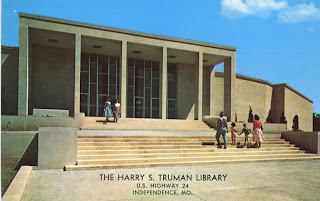Philip White
This past weekend, I spent a pleasant morning at the research room of the Harry S. Truman Library & Museum in Independence, Missouri. It was my third trip there, and the first for a new Book Project That Cannot Be Named. In the past couple of years, my research has also taken me to the National Churchill Museum in Fulton, Missouri (the town where Winston Churchill delivered his "Iron Curtain" speech in 1946), University of Missouri-Kansas City and, more exotically, the Churchill Archives Centre (yes folks, that’s the British spelling) in Cambridge, England.
I am far from a master researcher, but I have picked up some tips from others who’ve been on the road, and through sheer, exasperating trial and error. Here are a few of these:
1) Take a Digital Camera, Extra Battery, Tripod and Clicker Thingy
The days of me taking my crappy old Canon point-and-shoot camera, with its tiny lens that can’t take in a full legal size document even if I was suspended from the ceiling (think Tom Cruise in Mission Impossible) and manually adjusting the angle each time, are over. I’m going to invest in a "superzoom" model, tripod, extra battery and the clicker thingy that lets you take pics without touching the camera. I saw two guys using this technique recently and one told me that creating such a setup was the best advice a professor ever gave him. Bravo, prof! By using it, the guy avoided using the photocopier (you’re only allowed to photograph the first page of original, multi-page docs) and took each snap quickly, almost like he was some kind of hyper-efficient researching humanoid. Me? My POS Canon ran out of battery half way through, and I had to resort to reproducing multi-page letters through shorthand. Aaarrghhh! Never again.
2) Form a Relationship with an Archivist
I’m not suggesting a romantic dalliance, but rather a courteous professional exchange between the seeker of knowledge and the one who knows where it resides. If the archivist is on your side they can suggest boxes and folders (and sometimes even specific documents), pull these for you in advance so you can get going as soon as you arrive, and follow up with further suggestions later. Just don’t treat them like Google or act imperious, and do send follow up thank you notes and e-mails. Archivists are there to help respectful researchers, but they’re not part of a servant class.
3) Avoid Rabbit Holes
This is a case of "do what I say, not what I do." Even going into an archive room with a tightly focused, organized wish list is no guarantee of a successful session. The trouble – or, at least, my trouble, is that every document, memo and letter is interesting in its own way. It’s all too easy to get sidetracked and look up at the clock to find you’ve burned an hour going down a fascinating yet completely useless path that in no way advances your project. Focus, I say, focus!
4) Process Your Materials ASAP
When you’ve worn your brain to a frazzle with several hours or, if you have a forgiving spouse/partner/whatever, days of intensely focused research, it’s tempting to throw your hard won materials in a box and forget about them for a few weeks. The problem with this is that even if you’ve taken solid notes and prioritized your harvest, you will forget certain intangibles and details that you’d recall if you knuckled down for a while and scanned and/or filed what you’ve found in the appropriate manner. Following the first two steps of an efficient research and writing process – capture and organize – in quick succession makes it easier to get to the third step – retrieve – in the best possible way. The same goes for online research and the use of tools such as Evernote, which I find most useful if I create folders and use tags/keywords.
5) Keep Your Research Away From Small Children
Let’s just say that you’ll only let your five-year-old and two-year-old get into your archival materials once. Hopefully they won’t tear, eat or throw away what they find. Research commandment # 5: Thou shalt lock thy office door at all times.
Blog Archive
Popular Posts
-
. Historic Maps and Digital Mapping Roundup "Was your street bombed during the Blitz?" Telegraph , December 6, 2012 The year-long...
-
Randall Stephens Jean de Venette (ca. 1308-ca. 1369), a Carmelite friar in Paris, wrote about the horrifying devastation brought on by the ...
-
The Northwest Museum of Arts & Culture is throwing a big shindig on Saturday, September 22nd. The Fall Harvest Festival features a vari...
-
Jensen-Byrd building by Flickr user Terry Bain . (Thank you Terry for choosing Creative Commons licensing.) This morning we have some good n...
-
. Steve Marinucci, "Beatles' Apple has nothing to fear from 'Strange Fruit' film," Examiner , April 21, 2012 It fina...
-
Philip White November 30 was Winston Churchill’s birthday. 138 years after his birth, historians, politicians and the public are still as fa...
-
Eric B. Schultz Alan Lomax (left) with Richard Queen of Soco Junior Square Dance Team at the Mountain Music Festival, Asheville, North Carol...
-
History blogging is delicate proposition. I typically look for a topic which is sufficient to fill 3-5 paragraphs with perhaps that many lin...
-
[Update 12/10/12: I added a few lines beneath some of the photos to answer a few questions .] Friday was a good day, I got to watch one of m...
-
There is nothing I like better than finding a new archive of local history--particularly when it isn't local. Last week I tweeted a ques...








